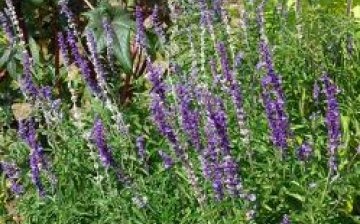Sage cultivation
Growing sage is easy. Sage is a perennial bush with an erect stem up to 60 centimeters high. Sage has narrow elliptical leaves, opposite, pointed. The ground part of the plant is covered with gray tomentose pubescence. Sage flowers are small, blue-violet, located in spike-shaped terminal inflorescences. Sage blooms in June or July.
Sage is grown in areas with a deep arable layer and special soil preparation. Previously, in the fall, it is necessary to apply manure and phosphorus-potassium fertilizers. And in the spring, nitrogen fertilizers are added, the site must be loosened. In April, seeds are sown to obtain seedlings. Seedlings are planted at the age of 30-40 days in the 5-leaf phase. After transplanting, the first month, the plants must be thoroughly watered, the aisle is loosened, and the weeds are destroyed. In the fall, you need to apply phosphorus-potassium fertilizers.
The sage plant is frost- and drought-resistant, it is not demanding on external factors when growing. Seed germination is carried out at a temperature of about 10 degrees in 2-3 weeks. The seedlings are very sensitive. Their initial development is slow. The ideal temperature for development is considered to be 20-30 degrees.
Sage leaves are harvested in the first year, this is done at the very beginning of flowering. Shoots are cut at a distance of 15-20 centimeters from the ground, then the plants need to be fed and watered at the rate of 7-10 liters per square meter.
Medicinal sage can also be grown in a pot on a windowsill in winter, and clary sage is covered with foil, an inverted box, earth, straw, and snow.



